Camarosporidiella,一个挑战。
摘要
本文对Camarosporidiella属的系统发育结构和物种组成进行了评估。从150多种新鲜采集的子囊孢子和分生孢子中制备了160多种纯培养物作为DNA来源,其中大部分来自豆科。分子系统发育分析表明,我们的分离物和前人的分离物的部分nuSSU-、完整ITS、部分LSU rDNA和tef1外显子序列的多基因矩阵不足以提供完整的物种分辨率。然而,从这个简化的数据矩阵中,我们提出了先前描述的物种的同义词和分类群,这些物种由于缺乏rpb2, tef1内含子和tub2序列而无法包括在最终的系统发育树中。根据nuSSU-ITS-LSU-rpb2-tef1-tub2组合序列矩阵推断的最终系统发育树将我们的分离株分解为27个统计支持的系统发育物种,其中15个是新的。Camarosporidiella共有34种。通过类型研究,我们对旧名进行了定名,对芦笋瓜、卡拉根瓜、乌氏瓜、褐皮瓜、褐皮瓜、长形瓜、褐皮瓜、Sphaeria spartii进行了分型鉴定,并对其进行了分型鉴定,对cytii葫芦、retamae葫芦、steineri葫芦进行了系统发育定位,确定了其分类概念。单靠形态学是不适合鉴别这些物种的,因此不能给出决定性的物种关键。然而,如果宿主被可靠地识别,许多物种可以在没有分子数据的情况下确定。宿主图像包括每个真菌种类的图形。分类学上的新发现:新种;acararosporidiella Jaklitsch & Voglmayr, aecararosporidiella Jaklitsch & Voglmayr, argoncamarosporidiella Jaklitsch & Voglmayr,天冬Camarosporidiella Jaklitsch & Voglmayr,黄龙Camarosporidiella Jaklitsch & Voglmayr, cretica Jaklitsch & Voglmayr, echinsparkarosporidiella Jaklitsch & Voglmayr, Camarosporidiella hesperolaburni Jaklitsch & Voglmayr, Camarosporidiella Jaklitsch & Voglmayr, Camarosporidiella Jaklitsch & Voglmayr, Camarosporidiella Jaklitsch & Voglmayr, Camarosporidiella Jaklitsch & Voglmayr, Camarosporidiella Jaklitsch & Voglmayr, Camarosporidiella Jaklitsch & Voglmayr,maroccana Camarosporidiella Jaklitsch & Voglmayr, ononidis Camarosporidiella Jaklitsch & Voglmayr,辐射Camarosporidiella Jaklitsch & Voglmayr, sparspartiocamarosporidiella Jaklitsch & Voglmayr,球形Camarosporidiella Jaklitsch & Voglmayr,三齿Camarosporidiella Jaklitsch & Voglmayr。新组合:Camarosporidiella asparagi (Maire) Jaklitsch & Voglmayr, Camarosporidiella caraganae (P. Karst.)Jaklitsch & Voglmayr, Camarosporidiella culteae (Rabenh.)Jaklitsch & Voglmayr, Camarosporidiella cytisi (Mirza)Jaklitsch & Voglmayr, Camarosporidiella euonymi(库克)Jaklitsch & Voglmayr, Camarosporidiella retamae(帕特)Jaklitsch & Voglmayr, Camarosporidiella steineri(彼得)Jaklitsch & Voglmayr。新名称:Camarosporidiella neomori Jaklitsch & Voglmayr, Camarosporidiella neospartii Jaklitsch & Voglmayr。引用本文:Jaklitsch WM, Blanco MN, rejs FJ, Tello S, Voglmayr H(2025)。Camarosporidiella,一个挑战。真菌学研究111:19-100。doi: 10.3114 / sim.2025.111.02。The genus Camarosporidiella is here assessed with respect to its phylogenetic structure and species composition. More than 160 pure cultures from ascospores and conidia of more than 150 fresh collections, mostly from Fabaceae, were prepared as DNA sources. Molecular phylogenetic analyses of a multigene matrix of partial nuSSU-, complete ITS, partial LSU rDNA, and tef1 exon sequences of our isolates and those of previous workers revealed that these markers are insufficient to provide a complete species resolution. From this reduced data matrix, however, we propose synonyms and accept taxa for previously described species, which could not be included in the final phylogenetic tree due to lack of rpb2, tef1 intron and tub2 sequences. The final phylogenetic tree, which was inferred from a combined nuSSU-ITS-LSU-rpb2-tef1-tub2 sequence matrix resolved our isolates into 27 statistically supported phylogenetic species, of which 15 are new. Altogether 34 species are here accepted in Camarosporidiella. Using type studies we stabilise old names, lectotypify Cucurbitaria asparagi, Cucurbitaria caraganae, Cucurbitaria coluteae, Cucurbitaria euonymi, Dichomera elaeagni Hendersonia mori, Sphaeria elongata, Sphaeria laburni Sphaeria spartii and epitypify them as well as Cucurbitaria cytisi, Cucurbitaria retamae and Cucurbitaria steineri to place them in their correct phylogenetic positions and fix their taxonomic concepts. Morphology alone is not suitable to identify these species, and therefore no determinative key to species can be given. However, if hosts are reliably identified, many species can be determined without molecular data. Host images are included with the figures of each fungal species. Taxonomic novelties: New species: Camarosporidiella aceris Jaklitsch & Voglmayr, Camarosporidiella aetnensis Jaklitsch & Voglmayr, Camarosporidiella aragonensis Jaklitsch & Voglmayr, Camarosporidiella asparagicola Jaklitsch & Voglmayr, Camarosporidiella astragalicola Jaklitsch & Voglmayr, Camarosporidiella cretica Jaklitsch & Voglmayr, Camarosporidiella echinosparti Jaklitsch & Voglmayr, Camarosporidiella hesperolaburni Jaklitsch & Voglmayr, Camarosporidiella longipedis Jaklitsch & Voglmayr, Camarosporidiella maroccana Jaklitsch & Voglmayr, Camarosporidiella ononidis Jaklitsch & Voglmayr, Camarosporidiella radiatae Jaklitsch & Voglmayr, Camarosporidiella spartioidis Jaklitsch & Voglmayr, Camarosporidiella sphaerocarpae Jaklitsch & Voglmayr, Camarosporidiella tridentatae Jaklitsch & Voglmayr. New combinations: Camarosporidiella asparagi (Maire) Jaklitsch & Voglmayr, Camarosporidiella caraganae (P. Karst.) Jaklitsch & Voglmayr, Camarosporidiella coluteae (Rabenh.) Jaklitsch & Voglmayr, Camarosporidiella cytisi (Mirza) Jaklitsch & Voglmayr, Camarosporidiella elaeagni (P. Karst.) Jaklitsch & Voglmayr, Camarosporidiella euonymi (Cooke) Jaklitsch & Voglmayr, Camarosporidiella retamae (Pat.) Jaklitsch & Voglmayr, Camarosporidiella steineri (Petr.) Jaklitsch & Voglmayr. New names: Camarosporidiella neomori Jaklitsch & Voglmayr, Camarosporidiella neospartii Jaklitsch & Voglmayr. Citation: Jaklitsch WM, Blanco MN, Rejos FJ, Tello S, Voglmayr H (2025). Camarosporidiella, a challenge. Studies in Mycology 111: 19-100. doi: 10.3114/sim.2025.111.02.

 求助内容:
求助内容: 应助结果提醒方式:
应助结果提醒方式:


